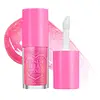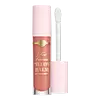Too Faced Kissing Jelly Non-Sticky Lip Oil Gloss Versus Too Faced Pillow Balm Hydrating Lip Treatment
What's inside
What's inside
 Key Ingredients
Key Ingredients

 Benefits
Benefits

 Concerns
Concerns

 Ingredients Side-by-side
Ingredients Side-by-side

Helianthus Annuus Seed Oil
EmollientPolybutene
Caprylic/Capric Triglyceride
MaskingEthylene/Propylene/Styrene Copolymer
Butylene/Ethylene/Styrene Copolymer
Bis-Diglyceryl Polyacyladipate-2
EmollientGlyceryl Caprylate
EmollientDiethylhexyl Syringylidenemalonate
Skin ProtectingPentaerythrityl Tetraisostearate
EmollientSimmondsia Chinensis Seed Oil
EmollientCalcium Sodium Borosilicate
Silica
AbrasiveTin Oxide
AbrasiveParfum
MaskingLimonene
PerfumingLinalool
PerfumingSodium Saccharin
MaskingPentaerythrityl Tetra-Di-T-Butyl Hydroxyhydrocinnamate
AntioxidantTocopheryl Acetate
AntioxidantCI 77891
Cosmetic ColorantCI 73360
Cosmetic ColorantMica
Cosmetic ColorantHelianthus Annuus Seed Oil, Polybutene, Caprylic/Capric Triglyceride, Ethylene/Propylene/Styrene Copolymer, Butylene/Ethylene/Styrene Copolymer, Bis-Diglyceryl Polyacyladipate-2, Glyceryl Caprylate, Diethylhexyl Syringylidenemalonate, Pentaerythrityl Tetraisostearate, Simmondsia Chinensis Seed Oil, Calcium Sodium Borosilicate, Silica, Tin Oxide, Parfum, Limonene, Linalool, Sodium Saccharin, Pentaerythrityl Tetra-Di-T-Butyl Hydroxyhydrocinnamate, Tocopheryl Acetate, CI 77891, CI 73360, Mica
Petrolatum
EmollientHydrogenated Polyisobutene
EmollientOctyldodecanol
EmollientBis-Diglyceryl Polyacyladipate-2
EmollientEthylene/Propylene/Styrene Copolymer
Synthetic Wax
AbrasiveVp/Hexadecene Copolymer
Tocopheryl Acetate
AntioxidantC12-15 Alkyl Benzoate
AntimicrobialPolyglyceryl-10 Heptahydroxystearate
Skin ConditioningPolydecene
Skin ConditioningSodium Hyaluronate
HumectantButyrospermum Parkii Butter
Skin ConditioningCocos Nucifera Fruit Juice
EmollientCocos Nucifera Oil
MaskingCucumis Sativus Fruit Extract
EmollientHelianthus Annuus Seed Extract
Skin ConditioningHordeum Vulgare Extract
EmollientMangifera Indica Seed Butter
Skin ConditioningOlea Europaea Fruit Oil
MaskingPersea Gratissima Oil
Skin ConditioningRicinus Communis Seed Oil
MaskingYogurt Powder
Lactobacillus Ferment
Skin ConditioningGlycerin
HumectantPhytosterols
Skin ConditioningMenthol
MaskingPropylene Glycol Dicaprate
EmollientMeteorite Powder
Skin ConditioningCholesterol
EmollientHydrogenated Castor Oil
EmollientSorbitan Oleate
EmulsifyingWater
Skin ConditioningButylene/Ethylene/Styrene Copolymer
Silica
AbrasiveSaccharin
MaskingParfum
MaskingBenzyl Benzoate
AntimicrobialLinalool
PerfumingLimonene
PerfumingTetrahexyldecyl Ascorbate
AntioxidantBHT
AntioxidantPhenoxyethanol
PreservativeMica
Cosmetic ColorantCI 77891
Cosmetic ColorantCI 77491
Cosmetic ColorantCI 77492
Cosmetic ColorantCI 77499
Cosmetic ColorantCI 77163
Cosmetic ColorantCI 42090
Cosmetic ColorantCI 15850
Cosmetic ColorantCI 45380
Cosmetic ColorantCI 45410
Cosmetic ColorantCI 17200
Cosmetic ColorantCI 19140
Cosmetic ColorantCI 15985
Cosmetic ColorantPetrolatum, Hydrogenated Polyisobutene, Octyldodecanol, Bis-Diglyceryl Polyacyladipate-2, Ethylene/Propylene/Styrene Copolymer, Synthetic Wax, Vp/Hexadecene Copolymer, Tocopheryl Acetate, C12-15 Alkyl Benzoate, Polyglyceryl-10 Heptahydroxystearate, Polydecene, Sodium Hyaluronate, Butyrospermum Parkii Butter, Cocos Nucifera Fruit Juice, Cocos Nucifera Oil, Cucumis Sativus Fruit Extract, Helianthus Annuus Seed Extract, Hordeum Vulgare Extract, Mangifera Indica Seed Butter, Olea Europaea Fruit Oil, Persea Gratissima Oil, Ricinus Communis Seed Oil, Yogurt Powder, Lactobacillus Ferment, Glycerin, Phytosterols, Menthol, Propylene Glycol Dicaprate, Meteorite Powder, Cholesterol, Hydrogenated Castor Oil, Sorbitan Oleate, Water, Butylene/Ethylene/Styrene Copolymer, Silica, Saccharin, Parfum, Benzyl Benzoate, Linalool, Limonene, Tetrahexyldecyl Ascorbate, BHT, Phenoxyethanol, Mica, CI 77891, CI 77491, CI 77492, CI 77499, CI 77163, CI 42090, CI 15850, CI 45380, CI 45410, CI 17200, CI 19140, CI 15985
 Reviews
Reviews

Ingredients Explained
These ingredients are found in both products.
Ingredients higher up in an ingredient list are typically present in a larger amount.
This ingredient is lipid-based synthetic skin-conditioning agent derived from adipic acid and a mixture of fatty acids. It is often called a lanolin substitute.
As an emollient, it helps soften and hydrate the skin. Emollients create a barrier on the skin to trap moisture in.
Due to its fatty acid base, it may not be Malassezia folliculitis safe.
Learn more about Bis-Diglyceryl Polyacyladipate-2We don't have a description for Butylene/Ethylene/Styrene Copolymer yet.
Ci 77891 is a white pigment from Titanium dioxide. It is naturally found in minerals such as rutile and ilmenite.
It's main function is to add a white color to cosmetics. It can also be mixed with other colors to create different shades.
Ci 77891 is commonly found in sunscreens due to its ability to block UV rays.
Learn more about CI 77891We don't have a description for Ethylene/Propylene/Styrene Copolymer yet.
Limonene is a fragrance that adds scent and taste to a formulation.
It's found in the peel oil of citrus fruits and other plants such as lavender and eucalyptus. The scent of limonene is generally described as "sweet citrus".
Limonene acts as an antioxidant, meaning it helps neutralize free radicals.
When exposed to air, oxidized limonene may sensitize the skin. Because of this, limonene is often avoided by people with sensitive skin.
The term 'fragrance' is not regulated in many countries. In many cases, it is up to the brand to define this term. For instance, many brands choose to label themselves as "fragrance-free" because they are not using synthetic fragrances. However, their products may still contain ingredients such as essential oils that are considered a fragrance.
Learn more about LimoneneLinalool is a fragrance and helps add scent to products. It's derived from common plants such as cinnamon, mint, citrus, and lavender.
Like Limonene, this ingredient oxidizes when exposed to air. Oxidized linalool can cause allergies and skin sensitivity.
This ingredient has a scent that is floral, spicy tropical, and citrus-like.
Learn more about LinaloolMica is a naturally occurring mineral used to add shimmer and color in cosmetics. It can also help improve the texture of a product or give it an opaque, white/silver color.
Serecite is the name for very fine but ragged grains of mica.
This ingredient is often coated with metal oxides like titanium dioxide. Trace amounts of heavy metals may be found in mica, but these metals are not harmful in our personal products.
Mica has been used since prehistoric times throughout the world. Ancient Egyptian, Indian, Greek, Roman, Aztec, and Chinese civilizations have used mica.
Learn more about MicaParfum is a catch-all term for an ingredient or more that is used to give a scent to products.
Also called "fragrance", this ingredient can be a blend of hundreds of chemicals or plant oils. This means every product with "fragrance" or "parfum" in the ingredients list is a different mixture.
For instance, Habanolide is a proprietary trade name for a specific aroma chemical. When used as a fragrance ingredient in cosmetics, most aroma chemicals fall under the broad labeling category of “FRAGRANCE” or “PARFUM” according to EU and US regulations.
The term 'parfum' or 'fragrance' is not regulated in many countries. In many cases, it is up to the brand to define this term.
For instance, many brands choose to label themselves as "fragrance-free" because they are not using synthetic fragrances. However, their products may still contain ingredients such as essential oils that are considered a fragrance by INCI standards.
One example is Calendula flower extract. Calendula is an essential oil that still imparts a scent or 'fragrance'.
Depending on the blend, the ingredients in the mixture can cause allergies and sensitivities on the skin. Some ingredients that are known EU allergens include linalool and citronellol.
Parfum can also be used to mask or cover an unpleasant scent.
The bottom line is: not all fragrances/parfum/ingredients are created equally. If you are worried about fragrances, we recommend taking a closer look at an ingredient. And of course, we always recommend speaking with a professional.
Learn more about ParfumSilica, also known as silicon dioxide, is a naturally occurring mineral. It is used as a fine, spherical, and porous powder in cosmetics.
Though it has exfoliant properties, the function of silica varies depending on the product.
The unique structure of silica enhances the spreadability and adds smoothness, making it a great texture enhancer.
It is also used as an active carrier, emulsifier, and mattifier due to its ability to absorb excess oil.
In some products, tiny microneedles called spicules are made from silica or hydrolyzed sponge. When you rub them in, they lightly polish away dead skin layers and enhance the penetration of active ingredients.
Learn more about SilicaTocopheryl Acetate is AKA Vitamin E. It is an antioxidant and protects your skin from free radicals. Free radicals damage the skin by breaking down collagen.
One study found using Tocopheryl Acetate with Vitamin C decreased the number of sunburned cells.
Tocopheryl Acetate is commonly found in both skincare and dietary supplements.
Learn more about Tocopheryl Acetate